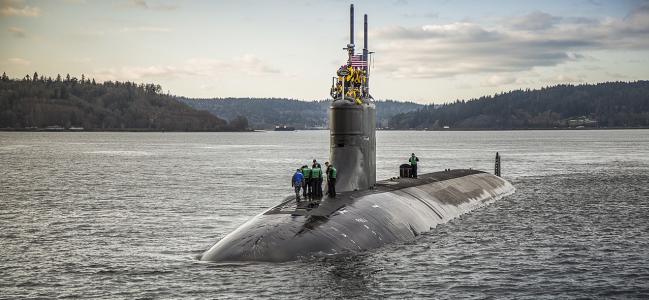 Yesterday, the US Navy Pacific Fleet announced that the Seawolf-class fast-attack submarine USS Connecticut struck an object in international waters while submerged on the afternoon of Oct. 2. While the announcement did not identify where the collision took place, reports are that it was in the South China Sea. Eleven sailors were reported to be hurt – two suffered moderate injuries and the rest had minor scrapes and bruises, officials said. All were treated on the sub.
Yesterday, the US Navy Pacific Fleet announced that the Seawolf-class fast-attack submarine USS Connecticut struck an object in international waters while submerged on the afternoon of Oct. 2. While the announcement did not identify where the collision took place, reports are that it was in the South China Sea. Eleven sailors were reported to be hurt – two suffered moderate injuries and the rest had minor scrapes and bruises, officials said. All were treated on the sub.
Today, the Navy says that the USS Connecticut has returned safely to port in Guam. The submarine’s nuclear propulsion plant and spaces were reported to not have been affected by the collision and to have remained fully operational. The extent of damage to the remainder of the submarine is being assessed.
According to AP, the officials said the object the USS Connecticut collided with was not another submarine. One of the officials quoted by the agency said it could have been a sunken vessel or container, or other uncharted object.
In comments reported by the Chinese state-run daily Global Times, a spokesman for the ministry of foreign affairs said China was “seriously concerned” about the incident, calling on the US to provide further details, including the purpose of the mission.
USS Connecticut is one of three Sea Wolf-class submarines, a late Cold War attack submarine designed to hunt the most complex Soviet submarines in deep blue water. Along with USS Sea Wolf (SSN-21) and USS Jimmy Carter (SSN-23), Connecticut is among the Navy’s most capable and sensitive attack boats.
Submarine collisions with other vessels or underwater objects are unusual but not unknown. In 2005, the USS San Franciso struck an underwater mountain at full speed near Guam. One sailor died and scores were injured. In 2008, the Royal Navy submarine HMS Superb hit an underwater pinnacle in the Red Sea. Fortunately, no one was seriously injured.
A year later in 2009, The Royal Navy’s HMS Vanguard and the French Navy’s Le Triomphant suffered a slow-speed collision in the Atlantic. Again, fortunately, no one was injured although both submarines were damaged.
In 2021, the Canadian submarine HMCS Corner Brook collided with the seafloor, seriously damaging the hull. After extensive repairs, the submarine only returned to service in June 2021.
Thanks to Alaric Bond and Irwin Bryan for contributing to this post.

Automatic loss of rank for the skipper? Or are the days of taking responsibility for expensive snafus over?